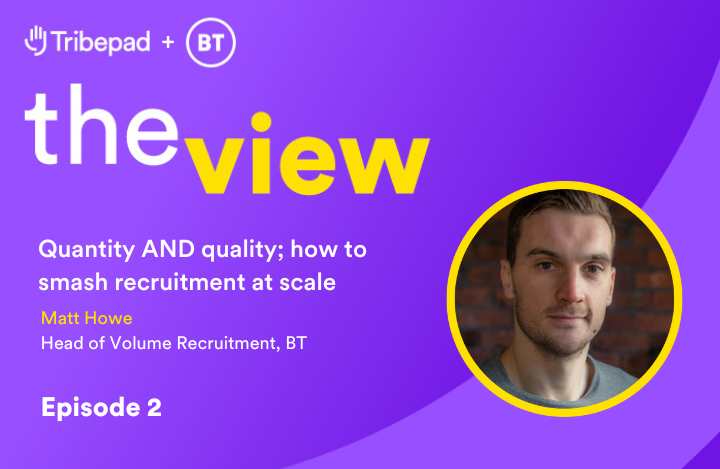When you hire many thousands of people each year, how do you juggle the urgent need for efficiency with delivering an excellent — and inclusive — candidate experience? Can you realistically focus on quality and quantity? How could AI change the world of volume hiring? We answer those questions and more with BT Group’s Head of Volume Recruitment, Matt Howe.
Matt is BT Group’s Head of Volume Recruitment, overseeing recruitment of 6500 to 12,000 people annually across brands like EE, PlusNet, and OpenReach. His team look after frontline hires, contact centres, retail stores, engineers, graduate recruitment, and any other high-volume campaigns happening, like temp-to-perm and internal reskilling.
Catch up on-demand here or keep reading for our key takeaways from the session.
Volume hiring: does org size matter?
Matt has enjoyed a career on both sides of the coin, having started his in-house recruitment career with PlusNet when they were a fast-growing scale-up before moving to BT.
For Matt, there are three big differences:
- Culture. A larger organisation has to have more structure. Teams are bigger and have typically been around longer. There’s more bureaucracy but also stronger, more established processes around recruitment that can make life easier.
- Speed. Smaller organisations are much nimbler, so can react fast to hiring requirements. You’re dealing with one or two sites, not 400 stores and 30 contact centres. As you grow, it takes longer and gets harder to do things well.
- Risk. When you mess up, a scale-up is dramatically more forgiving and you can remedy missteps fast. In an enterprise environment, things going wrong have a huge impact. In turn, that creates a more cautious decision-making environment. Scale-ups can afford to be scrappier.
Those differences raise some distinct challenges but the same principles apply. To build a successful high-volume recruitment function, efficiency is king, candidate experience is queen, and data is the palace everyone sits in.
5 tips to improve volume recruitment delivery
Here are some of the real-world tactics that Matt and his team rely on right now, to power volume recruitment for one of the UK’s largest employers.
- Embrace what’s required but remove what’s not
“Of course there’s more red tape when you recruit for a huge enterprise”, Matt says. But that’s your job: to work out how much red tape you can remove.
Often large organisations use their size as an excuse not to push themselves, I think. At BT we recruit with limitations around how we can do things and how fast we can move – but they’re the absolute minimum we can go for.”
- Build a fantastic team
“Your job’s easy with the right people in your team”. ‘Nuff said. Prioritise hiring and training great recruiters and they’ll go a long way to making difficult recruitment feel easy.
It’s a great point, because teams often over-index on talking about recruitment technology. Good recruitment tech is great (obviously). But software can only ever be part of the solution. Having great people around you is super important.
- Automate everything – to free people bandwidth
“We automate as much as we possibly can”, Matt says. “So then there’s always someone available for candidates to speak to personally. Our dropout rate is much higher before people speak to us. We used to outsource phone screening for example, but we’ve seen huge value bringing that in-house.”
Recruitment tech can turbocharge your team’s efficiency – but that doesn’t just mean you can recruit faster. It means your recruiters have more bandwidth to have the personal one-to-one conversations.
Those are what really move the needle in terms of quality-of-hire, application completions, candidate experience, and employer brand.
- Work on facts over feelings…
Data is absolutely pivotal for high-volume recruitment. “We need to know our volumes, our source-of-hire by cost and quality, our conversion rates throughout the funnel, so we can optimise the journey constantly”, Matt emphasises. “If you have the data you can work out fast which decisions to make. If not, you can’t.”
Plus, data is how you prove value upwards to other stakeholders. Recruitment will struggle to earn a place at the top table without robust data.
- …but still centre the candidate
“There’s a dichotomy here”, Matt points out. “Because decision-making must be guided by data. But it’s so important to put the candidate or customer at the heart of those decisions too.”
Data doesn’t take away the need for qualitative, sensitive conversations that contribute to understanding the bigger picture.
Matt shares an example around BT Group’s selection process:
If you looked solely at the data, you’d administer a ‘one one-size-fits-all’ group exercise for our contact centres. It’s time-efficient and allows for consistent decision-making. But actually, my team sit in with new starter groups regularly, to trial new ways of selecting people. We discovered from one neurodiverse candidate that they only came to the interview because we weren’t doing a group exercise, for instance. You wouldn’t see that perspective in the data-set – but those are the perspectives we want, to build a process that works better for everyone.
Let’s talk about some of the other hurdles to great high volume hiring.
Navigating a candidate-driven market
Matt opened up about some of the challenges BT Group have faced from a recruitment perspective since the pandemic.
Like many employers, they’re struggling with a candidate-driven market that makes it harder to hire. Especially for contact centre and other entry level positions, the market has totally changed.
- Less wage differentiation encouraging broad applications.
- Lower loyalty and increased drop-outs.
- High early attrition worsening the pressure on recruiters.
Matt talks about how this candidate-driven market puts a premium on candidate experience and employer brand. But also how that can be challenging in a market-leading organisation, where there’s often a perception that the brand is strong enough as-is.
“We need to be absolutely clear on who we attract, and why. Not just attracting more applications. Then we can work backwards to build brilliant recruitment experiences tailored to the people we want. There’s no time for employer complacency anymore. It’s not just – post an ad, then hire, now. Brand matters. Your value proposition matters. Everything we do – within recruitment and across the brand – should complement the people we’re trying to hire.”
Who are your ideal hires? What do they care about? And how do you stack up?
Juggling volume with inclusion
One major discussion point with Matt was what’ll be a key concern for many volume hiring teams: how do you optimise for efficiency, while also building a fair, inclusive recruitment process? Can you do both?
For Matt and his team, the answer is yes (although there’s always more you can do). Here are a couple of things that work for BT’s volume team.
- Segmenting attraction and selection
Matt talks about the importance of building a personalised recruitment process that accommodates different employee groups.
For instance, they’d noticed they were struggling to help apprentices thrive with their current recruitment process so they pulled apprentice recruitment into a different stream with a specialised process and support.
And now they have a steady stream of apprentices coming into and up through the group.
- Comparing recruitment data to demographic data
Matt and his team compare their recruitment data to ONS data for the local area, starting from application, to see if they’re bringing a representative sample of people into the organisation.
Here’s an example of data driving ED&I in action:
With this data, they could spot that they were attracting lots of candidates from diverse ethnic origins but weren’t ultimately hiring them. When they dug into this, they saw they were attracting many applications from international students who could only work a certain number of hours on a student visa.
Knowing this, they could address this by creating part-time student suitable shifts – to increase representation in the student community.
Key results:
💛🩷 Learn more about how the right recruitment tech can help you deliver on diversity. 💚💙
Or listen to our discussion with Fosway about ED&I here
How could AI transform volume recruitment?
We couldn’t let Matt escape without asking him about the burning question on everyone’s lips right now… AI.
Since ChatGPT thrust conversational generative AI onto the scene, the AI discussion is everywhere. And with its high-volume of repetitive tasks and premium on efficiency, volume recruitment is a clear candidate for AI transformation.
But what does Matt think?
It comes back to what Matt was saying earlier. In volume recruitment, it’s so easy to focus on efficiency, efficiency, efficiency. And of course, efficiency matters. But getting offers out fast makes no difference if nobody accepts them. Or accepts them but leaves after a week.
“There’s no doubt AI will change recruitment. It’ll change the nature of jobs, which’ll then change training and reskilling. And it has lots of application throughout the recruitment journey.
I think we’ll see some organisations using AI to talk to candidates less and save money. But the organisations that get AI right will use it to create more time to talk to candidates and improve the candidate experience.”
It comes back to what Matt was saying earlier. In volume recruitment, it’s so easy to focus on efficiency, efficiency, efficiency. And of course, efficiency matters. But getting offers out fast makes no difference if nobody accepts them. Or accepts them but leaves after a week.
Brands that win – even those hiring for huge volumes of entry-level roles – will be those who prioritise employer brand, prioritise ED&I, and prioritise the people at the heart of the process.
Matt Howe, Head of Volume Recruitment for BT Group, spoke to Tribepad’s Neil Armstrong for the second episode of Tribepad’s The View – a new series bringing you expert advice from across the world of recruitment and HR. Catch up on-demand here.
Tribepad is the trusted tech ally to smart(er) recruiters everywhere. Combining ATS, CRM, Video Interviewing, and Onboarding, our talent acquisition software is a springboard for faster, fairer, better recruitment for everyone.
Trusted by organisations like Compass Group, Tesco, NHS Professionals, Sodexo, Signature, Tarmac and Subway, 25-million people in 16 languages use Tribepad.

